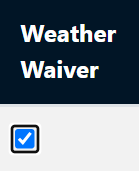Cadet Physical Fitness Test (CPFT) Administration
CPFT testing standards (scores) are at the end of this page.
Compliance with CAP Regulation 60-1
CAPR 60-1 Cadet Program Management (Chapter 5: Cadet Advancement) provides the directive for fitness as a required assessment area in order for cadets to promote through the program. Compliance with CAPR 60-1 is mandatory.
This web page is intended to provide further guidance for the administration of the CPFT to meet CAP standards and is not intended to substitute or deviate from CAP regulation.
Reference to CAP Pamphlet 60-50
CAPP 60-50 Active Cadet Fitness Guide (Chapter 5: Assessment) provides the concept of the CPFT and standards for successful achievement of testing requirements. Adherence to CAPP 60-50 standards is mandatory for cadets to meet promotion criteria.
CAPP 60-50 also provides for additional Cadet Program fitness information, to include suggestions for non-testing fitness activities and personal goal-setting.
Requirement to Provide Fitness Testing
The unit is required to administer a squadron-level CPFT once per quarter (3-month period).
Presidential Youth Fitness Program
The Presidential Youth Fitness Program (PYFP) is a fitness initiative for grade schools throughout the United States to promote health and regular physical activity for America's youth.
The Cadet Program employs the PYFP in the implementation of the CPFT in support of the national vision for youth/teen health.
Visit PYFP.org for more information.
Healthy Fitness Zone
Healthy Fitness Zone (HFZ) defines where in the boundaries of fitness performance that an individual should be capable in their performance based on their age and gender. Each testing exercise of the CPFT will change in score parameters (success criteria) as cadets get older, adapting to greater physical demands and physical capabilities as they mature.
While the CPFT provides a test score approach, the intent of the assessment is to ensure that cadets fall within their intended HFZ. Thus, cadets who achieve HFZ in all required testing exercises have passed their CPFT.
NOTE: While the PYFP measures aerobic capacity using Body Mass Index (BMI), CAP does not implemented this practice for CPFT testing exercises.
Testing Exercises
The CPFT consists of the following exercises to serve as areas for fitness assessment:
-
1-Mile Run — Measures aerobic capacity across a timed, continuous run for 1 mile
-
Progressive Aerobic Cardiovascular Endurance Run (PACER) — Measures aerobic capacity across a timed series of 20-meter (65.62-foot) laps which decrease in time (increase in speed) over the duration of the exercise
-
Curl-Ups — Measures abdominal strength and endurance while following a cadenced (counted) pace, 1 curl every 3 seconds
-
Push-Ups — Measures upper body strength and endurance while following a cadenced (counted) pace, 1 complete push-up to 90° every 3 seconds
-
Sit-and-Reach (Back-Saver Modification) — Measures flexibility of the hamstring muscles while exercising the joints
NOTE: The unit only needs to administer one of the aerobic capacity (Mile Run or PACER) exercises for testing. The Sit-and-Reach exists as an option for administration but does not need to be administered if Curl-Ups and Push-Ups are administered (see "Passing the CPFT" below).
Passing the CPFT
Successful passing of the CPFT requires that cadets:
-
Achieve HFZ for either the Mile Run or PACER, and
-
Achieve HFZ at least two (2) of the following:
-
Curl-Ups
-
Push-Ups
-
Sit-and-Reach
-
NOTE: While some cadets may perform better on one particular exercise over another, the unit administers testing which serves the predominant population of the cadet corps as well as the geographical/logistical constraints of testing facilities available.
Cadets must meet HFZ in all required categories in order to successfully pass the entire CPFT. A failure to meet HFZ in any required exercise results in complete CPFT failure.
Passing of the CPFT is valid for 180 days (6 months) from the date of successful test completion. Cadets do not need to re-test once passed in order to achieve additional promotions within that timeframe.
Example:
A Cadet Staff Sergeant passes their CPFT on January 15. Their CPFT is valid until July 14.
The cadet promotes to Cadet Technical Sergeant on January 20. They are eligible for Cadet Master Sergeant on March 17. They promote to Cadet Master Sergeant on March 25 without having completed their CPFT since January 15.
The cadet is now eligible to promote to Cadet Senior Master Sergeant on May 20. They promote on May 20 without having completed their CPFT since January 15.
The cadet is now eligible to promote to Cadet Chief Master Sergeant on July 15. The cadet has still not completed their CPFT since January 15. They will not be eligible to promote come July 15 because their CPFT is no longer current/valid.
Attempt versus Pass
While the CPFT is required for most cadet promotions, the first three cadet achievements (Cadet Airman through Cadet Senior Airman) do not require passing the CPFT in order to promote. Cadets at these grades only need to attempt the CPFT under the intent of establishing a baseline level of performance and areas which may require improvement by the time the cadet needs to achieve HFZ.
The unit ensures that new Cadet Airman Basic recruits complete their CPFT as part of the Basic Cadet Training program.
Waivers for Illness, Injury, or Physical Limitation
Click here for the unit's policy on physical fitness and injury restrictions.
Waivers for Weather
In the event that weather is inclement (e.g., extreme cold, precipitation), resulting in the inability to safely and/or fairly administer the CPFT, a Weather Waiver may be provided to provide a 30-day extension to previously-passed CPFT attempts.
The HFZ Entry module in eServices allows data entrants to input the Weather Waiver in lieu of CPFT scores.
NOTE: Entering the Weather Waiver will waive all of the HFZ score entries for that individual.

CPFT Standards (HFZ Requirements)
NOTE: The standards shown in the tables below include ages under 12 years due to CAP permitting cadets to join school-based squadrons starting in the 6th grade.
1-MILE RUN
Minutes:Seconds
|
AGE |
MALE |
FEMALE |
|---|---|---|
|
10 |
11:30 |
11:30 |
|
11 |
11:10 |
11:10 |
|
12 |
10:40 |
10:40 |
|
13 |
9:46 |
10:20 |
|
14 |
9:22 |
10:09 |
|
15 |
9:04 |
9:58 |
|
16 |
8:42 |
9:46 |
|
17 |
8:22 |
9:34 |
|
18+ |
8:04 |
9:22 |
PACER
Number of laps
|
AGE |
MALE |
FEMALE |
|---|---|---|
|
10 |
17 |
17 |
|
11 |
20 |
20 |
|
12 |
23 |
23 |
|
13 |
29 |
25 |
|
14 |
36 |
27 |
|
15 |
42 |
30 |
|
16 |
47 |
32 |
|
17 |
50 |
35 |
|
18+ |
54 |
38 |
CURL-UPS
Number of Repetitions
|
AGE |
MALE |
FEMALE |
|---|---|---|
|
10 |
12 |
12 |
|
11 |
15 |
15 |
|
12 |
18 |
18 |
|
13 |
21 |
18 |
|
14 |
24 |
18 |
|
15 |
24 |
18 |
|
16 |
24 |
18 |
|
17 |
24 |
18 |
|
18+ |
24 |
18 |
PUSH-UPS
Number of Repetitions
|
AGE |
MALE |
FEMALE |
|---|---|---|
|
10 |
7 |
7 |
|
11 |
8 |
7 |
|
12 |
10 |
7 |
|
13 |
12 |
7 |
|
14 |
14 |
7 |
|
15 |
16 |
7 |
|
16 |
18 |
7 |
|
17 |
18 |
7 |
|
18+ |
18 |
7 |
SIT-AND-REACH
Average Inches
(between two attempts)
|
AGE |
MALE |
FEMALE |
|---|---|---|
|
10 |
8 |
9 |
|
11 |
8 |
10 |
|
12 |
8 |
10 |
|
13 |
8 |
10 |
|
14 |
8 |
10 |
|
15 |
8 |
12 |
|
16 |
8 |
12 |
|
17 |
8 |
12 |
|
18+ |
8 |
12 |
Spaatz Exam Requirements
The Spaatz Exam falls outside of the scope of CPFT/HFZ assessment. Spaatz testing includes its own fitness assessment which is a modified version of the U.S. Air Force Academy Candidate Fitness Assessment (CFA). The standards of the CFA do not change with age.
The Spaatz Exam is administered at the Wing level and requires special approval. Contact cadetprograms@ohwg.cap.gov for assistance regarding the Spaatz Exam.
SPAATZ EXAM
1-Mile Run: Minutes:Seconds
Push-Ups: Repetitions in 120 seconds
Sit-Ups: Repetitions in 120 seconds
|
EVENT |
MALE |
FEMALE |
|---|---|---|
|
1-MILE RUN |
6:29 |
7:30 |
|
SIT-UPS |
81 |
78 |
|
PUSH-UPS |
62 |
41 |





